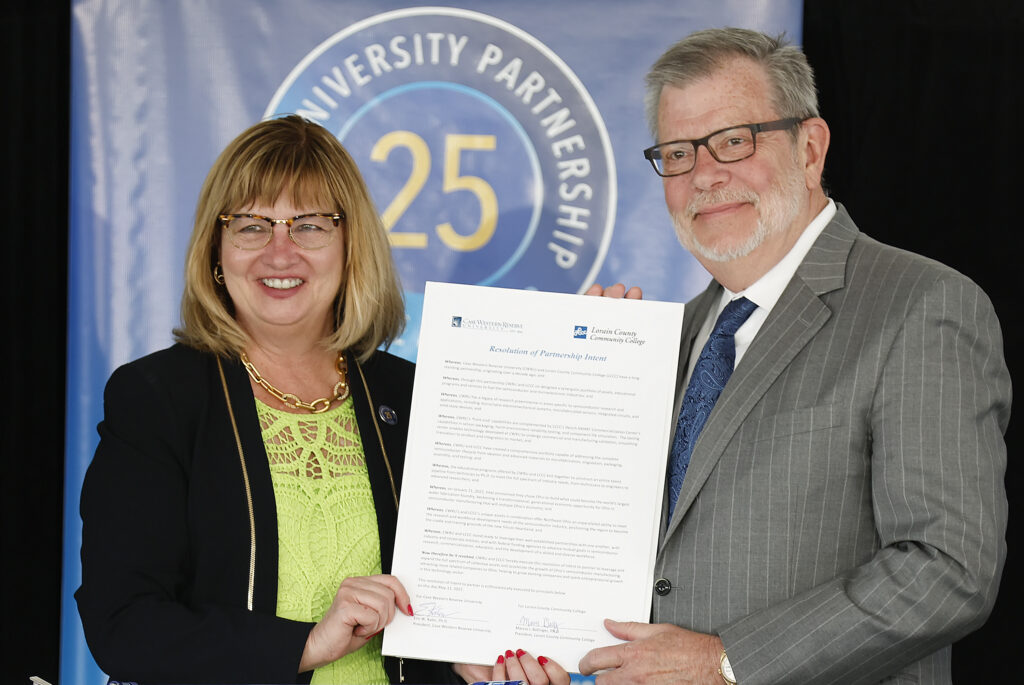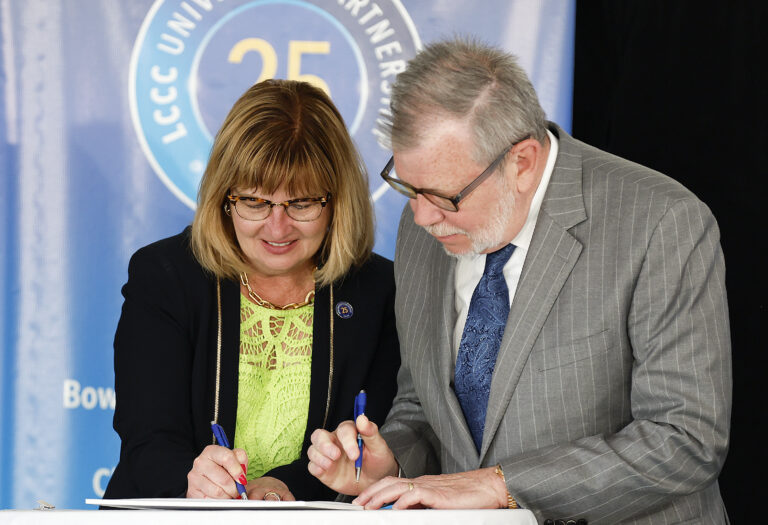Case Western Reserve University (CWRU) President Eric W. Kaler and Lorain County Community College (LCCC) President Marcia J. Ballinger on Wednesday announced the two institutions are teaming up to help fuel Northeast Ohio’s emerging semiconductor economy.
The partnership builds off more than a decade of capacity building in this area at both institutions and was inspired by Intel’s January 2022 announcement that it will locate in Ohio what could become the world’s largest semiconductor microchip factories, known as wafer fabrication plants.
The higher education leaders signed a resolution of partnership making the commitment to align assets at both institutions to accelerate research, commercialization and talent development related to semiconductors and microelectronics.

“This collaboration brings together two institutions that have complementary strengths in semiconductors and microelectronics—as well as extensive experience in working together,” Kaler said. “From ground-breaking research to innovative approaches to preparing students for opportunities in these fields, our institutions are uniquely positioned to respond to the opportunities that Intel’s presence is creating for Ohio.”
CWRU has a legacy of research preeminence in the areas specific to semiconductor research and applications, including micro/nano-electromechanical systems, microfabricated sensors, integrated circuits and solid-state devices. CWRU’s front-end capabilities are complemented by LCCC’s strength in sensor packaging, harsh environment reliability testing and component life simulation through the Desich SMART Center.
Combining these resources creates an unparalleled portfolio to accelerate the translation of semiconductor novel research to commercial applications, resulting in industry and job growth, according to representatives from both institutions.
“Together, Lorain County Community College and Case Western Reserve University are equipped to construct an entire educational pipeline from certificates to PhDs to meet the full spectrum of industry needs from technicians to engineers and advanced researchers,” said Ballinger. “This continuum of talent-growth resources positions the region to become the cradle and training grounds of the new Silicon Heartland.”
Intel’s decision to locate in Ohio will have an economic ripple effect across the state. It’s projected the company’s arrival will bring an additional 30 to 40 supply chain companies and expand the existing 140 Intel supply chain partners, many of which are already in Northeast Ohio. The unique, combined resources CWRU and LCCC will provide can serve as an even greater incentive for semiconductor companies and supply chain partners to choose Northeast Ohio for expansion, regional economic leaders said.
“Ohio’s economy is experiencing a major tipping point. Similar to when the automotive and steel industries took root in the Great Lakes region, the arrival of Intel and follow-on supply chain companies brings a transformational economic opportunity to all parts of Ohio,” said Bill Koehler, chief executive officer of Team NEO. “The combined and expanding resources of Case Western Reserve University and Lorain County Community give our region a unique competitive advantage to fully leverage this moment for industry and job growth.”
The two institutions have a successful history of partnership. CWRU and LCCC were original partners in the State of Ohio investment that led to the creation of the Desich SMART Center on LCCC’s campus. Both institutions were early movers and partners in developing state-of-the-art innovation centers with robust maker spaces: Sears think[box] at CWRU and the Campana Center for Ideation and Innovation at LCCC. This track record of partnership and collaboration has prepared the institutions to lead Northeast Ohio in expanding the semiconductor industry and elevating existing advanced manufacturing.
“This alliance, which builds on the complementary strengths of these institutions, supports talent pipelines for Intel, its suppliers, and other smart manufacturing companies. As talent is a key factor in business decisions, these programs make our region even more attractive for growing advanced manufacturing firms,” noted Baiju R. Shah, president and CEO of the Greater Cleveland Partnership.


